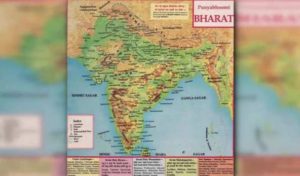
Akhand Bharat is going to be a reality soon. Or so says RSS Chief Mohan Bhagwat. To put it in his words on Wednesday (April 13), “India will again become ‘Akhand Bharat’ in 15 years.
We all will see this with our own eyes.” Bhagwat’s comments came in response to a statement made by Akhil Bharatiya Akhara Parishad president Swami Ravindra Puri (of Mahanirvani Akhara), who said, “Astrological predictions suggest that we will realise the dream of Akhand Bharat in the next 20-25 years.” What is RSS’s Akhand Bharat?Rashtriya Swayamsevak Sangh has been endorsing the idea of Akhand Bharat – which includes the nations in the subcontinent in its ambit – since the Partition. The idea is that of a ‘unified India’ that includes modern-day Pakistan, Afghanistan, Bangladesh, Nepal, Bhutan, Tibet, Sri Lanka, Maldives and Myanmar as a part of India. According to BJP general secretary Ram Madhav’s interview with Al Jazeera in December 2015, “The RSS still believes that one day [India, Pakistan and Bangladesh], which have for historical reasons separated only 60 years ago, will again, through popular goodwill, come together and Akhand Bharat will be created.” It is not a narrative that was formed in the recent past. Madhav Sadashiv Golwalkar – RSS’s second sarsanghchalak and the man who shaped the organisation for over three decades – said at a press conference in Delhi on August 24, 1949, that Pakistan was an “uncertain state”.
As an oft-repeated view he said, “As far as possible, we must continue our efforts to unite these two divided states. If Partition is a settled fact, we [the RSS] are here to unsettle it.” The idea of Akhand Bharat goes beyond Pakistan. Bodhmala, a textbook on cultural knowledge published by Haryana-based Vidya Bharti Sanskriti Shiksha Sansthan, the RSS’s formal education wing, answers the question “Which are the countries along our present-day border that were once part of our country?” thus: “Brahmadesh (Myanmar) and Bangladesh to the east, Pakistan and Afghanistan to the west, Tibet, Nepal and Bhutan to the north, and Sri Lanka to the south.” The text also refers to the Bay of Bengal as “Ganga Sagar” the Arabian Sea as the “Sindhu Sagar” and the Indian Ocean as the “Hindu Mahasagar.” These books form a part of the curriculum in the 12,828 schools across India run by Vidya Bharti with 34.6 lakh students and about 1.5 lakh teachers. These schools are affiliated with the CBSE and various state boards.
Similarly, Suruchi Prakashan, a publishing house run by the RSS, has brought out a map called ‘Punyabhoomi Bharat’ in which Afghanistan is called “Upganathan”, Kabul is called “Kubha Nagar”, Peshawar is called “Purushpur”, Multan is called “Moolsthan”, Tibet is called “Trivishtap,” Sri Lanka is called “Singhaldweep” and Myanmar is called “Brahmadesh”. The combined region of the countries is termed a “Rashtra” (country) which is based on “cultural similarities” with Hinduism. In fact, the idea of creating an Akhand Bharat has been intrinsically and ideologically linked with the thesis of Hindutva and the ideas of sangathan (unity) and shuddhi (purification) – the pillars of the RSS’s principles. Pre-independence, the RSS, Hindu Mahasabha and like-minded organisations believed that the British wanted to break the concept of Akhand Bharat and employ the divide-and-rule policy.
Propounding the notion of an Akhand Bharat that “must remain one and indivisible” Hindu Mahasabha leader VD Savarkar said in 1937 that it stretches from “from Kashmir to Rameswaram, from Sindh to Assam.” Subsequently, RSS saw the Partition of India as the death knell on the Akhand Bharat dream and hasn’t been charitable to the leaders who have advocated the creation of Pakistan, from Jinnah, Gandhi, and Nehru to even Patel. In his book `The Tragic Story of Partition’ RSS ideologue HV Seshadri, for instance, has unflattering references to Nehru and Patel, as the author clubs both the leaders and holds them responsible for Partition. He further writes, “What took place on the August 14-15, 1947, was this gross betrayal of the nation’s faith, the betrayal of the dreams of countless fighters and martyrs who had plunged into the fire of freedom struggle with the vision of Akhand Bharat in their hearts.” Even today, while the BJP leadership might waver on the issue, the RSS has always stood strong on the idea. Even today, the RSS-affiliated magazine Organiser publishes editorials by leaders including Mohan Bhagwat, espousing the philosophy that only Akhand Bharat and sampoorna samaj (united society) can bring “real” freedom to the people of India.
So strong has been the intent that the RSS has been observing the “Akhand Bharat Day” on August 14 every year, channelling its vision by having like-minded ideological advocates discussing the realisation of the dream of a “united” India. In the past, Bhagwat has summed up the RSS’s principle on the issue, saying that if Hindus want to remain Hindus then Bharat has to be made “Akhand”. And two days ago, he said that “no one can stop India from achieving its goal”. “Isko rokne wale hat jayenge ya mit jayenge (Those trying to impede the country’s march forward will either move away or not remain).”




 Driving Naari Programme launched in Chandigarh
Driving Naari Programme launched in Chandigarh






























